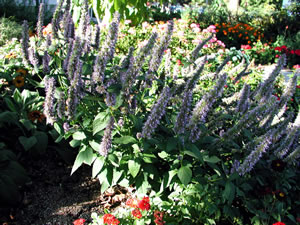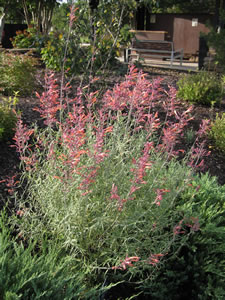Resource Library
Plant of the Week: Hyssops, Giant
The University of Arkansas System Division of Agriculture does not promote, support or recommend plants featured in "Plant of the Week." Please consult your local Extension office for plants suitable for your region.
Plant of the Week
Giant Hyssops
Latin: Agastache Giant Hyssop

I must admit to my biases. Though I like all plants, it is hard for me to get excited about another member of the mint family. So, when new Agastache hybrids began showing up in nursery catalogs during the close of the last century I was not tempted to try them. Slowly they have crept into my consciousness so now it is time to consider them more closely.
The genus Agastache consists of nine to 16 species, all of which save one are native to North America. Unfortunately for gardeners they don’t have a good common name that makes sense when applied to all of the hybrids so adopting the Latin moniker as a common name probably is the best idea. The name Blue Giant Hyssop or Anise-Hyssop is applied to some of the tall, broad-leaved forms but is meaningless when used on the narrow-leafed forms with leaves that smell more like licorice.
Agastache are erect growing perennial, somewhat woody herbs of the mint family that can be roughly divided into two groups. The northern (and the one Asian) species grow 4 to 6 feet tall with opposite, broad, lanceolate-shaped, toothed leaves arranged up the square stems. The leaves do not smell minty but instead smell more like anise, a member of the carrot family. Though associated by common name to Hyssop, Agastache is not closely related to that Mediterranean species. Flower colors are usually blue or purple in the northern cultivated forms with A. foeniculum the most commonly used species to create the garden hybrids.
The Southwestern Agastache are more compact in habit, usually growing about 2 feet tall and wide. Plants usually have narrow, sometimes gray-green leaves that have a range of scents but are not minty in nature. Blooms appear during the heat of summer and are held upright on many-flowered spikes. These species have hot colored blooms in shades of pink and red with A. rupestris and A. cana the most commonly used forms in creating the garden hybrids.

The genus Agastache was created by John Clayton (1695 – 1773), a prominent early American amateur botanist who corresponded with a Dutch botanist, John Frederick Gronovius. During the 1730s Clayton put together a treatise on the native plants of Virginia using the new Linnaean system of naming and sent a copy to Gronovius who, unbeknownst to Clayton, had it translated to Latin and published under his own name as the Flora of Virginia. The name Agastache, as coined by Clayton, translates aptly as “many spikes.” The Southwestern species remained unknown until the latter part of the 19th century when botanists began making collecting forays into that region.
Gardeners interested in growing Agastache need to keep in mind the distinction between the northern and southwestern species. While all Agastache tend to be short-lived in the garden, usually fading away in 3 or 4 years, their demise can be hastened by locating them in the wrong spot. Clay soils are a death sentence for all Agastache. The broad-leaved and blue-flowered forms need a sunny site with good summertime moisture but by no means the hottest location in the garden. These plants are typically considered hardy from zones 5 through 8.
The narrow-leaved species with the hot flowers hail from drier, hotter climes and are best in locations that mirror those conditions. Planting on southern or westerly exposures that have excellent wintertime drainage will reduce the likelihood of wintertime crown rot. These hybrids will tolerate xeric conditions but better flowering is attained by keeping them watered during the driest months. Don’t cut the plants back until spring to lessen the likelihood of crown rot. They tend to do less well in cold winter-wet climates and are best in zones 6 through 9.
The larger Agastache hybrids such as ‘Blue Fortune’, ’Black Adder’ ‘Tutti Frutti’ or ‘Golden Jubilee’ are good candidates for use in the mixed border or in mass plantings. Threadleaf hybrids such as ‘Heatwave’, ‘Firebird’ or ‘Ava’ are good in rock gardens and more exposed locations where they have good air circulation. Most of the new Agastache hybrids hitting the market each spring are being produced by Dutch breeders.
By: Gerald Klingaman, retired
Retired Extension Horticulturist - Ornamentals
Extension News - October 28, 2011
The University of Arkansas System Division of Agriculture does not maintain lists of retail outlets where these plants can be purchased. Please check your local nursery or other retail outlets to ask about the availability of these plants for your growing area.